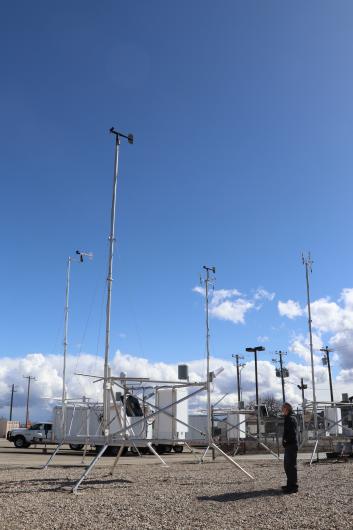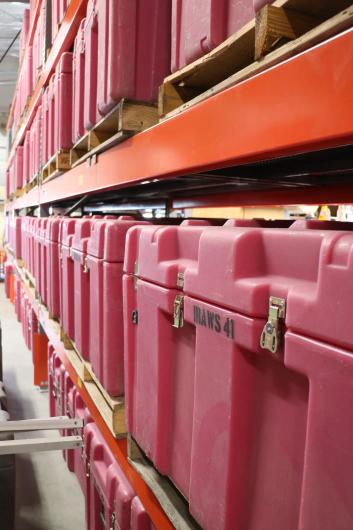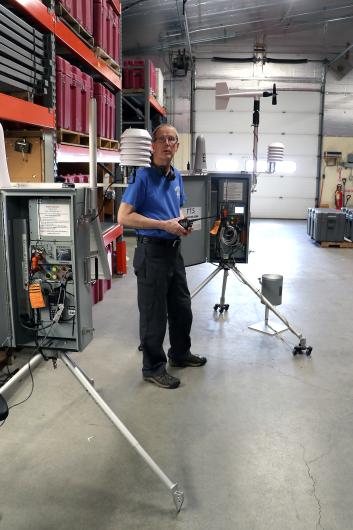You are viewing ARCHIVED content published online before January 20, 2025. Please note that this content is NOT UPDATED, and links may not work. Additionally, any previously issued diversity, equity, inclusion or gender-related guidance on this webpage should be considered rescinded. For current information, visit https://www.blm.gov/blog.
Who runs the BLM’s remote automatic weather stations?
Nothing is more important on the fireline than knowing what is going on with the weather. Every rookie firefighter's training includes the 10 Standard Fire Orders, of which number one is: “Keep informed on fire weather conditions and forecasts.” When topography, elevation, extreme weather fluctuations, and the presence of wildfire are in play, it’s essential to gather highly localized weather data. It is a job for remote automatic weather stations (RAWS).
Here at the National Interagency Fire Center (NIFC) in Boise, Idaho, the BLM operates the Remote Sensing Fire Weather Support Unit, which supports a growing infrastructure of more than two thousand RAWS, strategically placed throughout the U.S., Puerto Rico, Guam, and the U.S. Virgin Islands.

“The primary purpose of RAWS is to preserve life and property,” says Branch Chief Robert Swofford. “They are constantly gathering information that is used to make decisions in the field every day. At the same time, they’re creating an incredible long-term data set, which supports fields like climatology.”

The two main groups that make up Swofford’s shop are the depot unit, responsible for calibration and repair in house, and the field unit, responsible for calibration and installation in the field.
Standard RAWS units are semi-permanent, 20-foot aluminum structures erected in remote, wild locations, from the alpine tundra of Alaskan mountain ranges to the desert floor of the Southwest. RAWS are solar-powered, and measure wind speed and direction, air temperature, rainfall, relative humidity, solar radiation, and fuel moisture. Some can measure soil moisture and temperature. Assembling a new RAWS, usually miles from the nearest road, is a big project that often utilizes aircraft, bringing the unit to the site piece by piece.
Incident RAWS, or IRAWS, are smaller, portable units used to meet more temporary needs for weather information, mainly due to wildfires or other natural disasters. There are 75 IRAWS housed at NIFC, sent out to the field throughout the fire year, and then returned and serviced in preparation for their next deployment. IRAWS transmit data every 15 minutes, whereas standard RAWS only transmit on the hour, a key difference as the smaller units are typically deployed to active, evolving incidents. IRAWS can also be programmed to transmit a radio alert when they detect potentially hazardous conditions, such as wind shifts, heat above a programmed level, or relative humidity below a programmed level.


The data from RAWS stations is transmitted via satellite and is housed in several locations, including publicly available sites where anyone can search for data near their area.
Naturally, this huge network requires regular maintenance. While IRAWS return home to NIFC for service, standard RAWS need to be visited in the field annually to ensure that they remain in compliance. This work is sometimes done by local employees, and sometimes by BLM field technicians, who travel to federal and state lands in the continental U.S., Alaska, Hawaii, Puerto Rico, and the U.S. Virgin Islands. While actively servicing a station takes most technicians no more than ninety minutes, these hard-working employees spend the relatively snow-free months in a constant cycle of preparing to travel, traveling to remote locations, processing equipment and data, and then starting it all over again.
Swofford comes to his current position by way of field work. An Air Force veteran with a degree in weather equipment maintenance, he worked as an electronics technician for the oil industry before joining the federal government servicing RAWS equipment. He ultimately worked his way up to supervising the national shop. Of the many beautiful places he has visited on duty, Swofford has strong memories of ancient cliff dwellings in New Mexico, and anywhere that he could spot interesting wildlife. During his travels, he has seen owls, eagles, wolves, bears, lizards, and more.
The BLM RAWS program is growing. Until recently, Swofford’s team was responsible for servicing about 350 stations for the BLM, as well a small number for the U.S. Forest Service and other entities. In 2023, the unit took over the servicing of RAWS stations deployed on lands managed by the Bureau of Indian Affairs, and as of October 2023, on U.S. Forest Service units nationwide. This effectively doubles the scope of the unit’s responsibility. Permanent field offices are now located in Boise, Idaho; Phoenix, Arizona; and Carson City, Nevada, and many new positions have been created. Swofford is looking forward to the first summer season following this massive expansion and considers it a testament to the good work done thus far by all the talented technicians and managers that make up the program.
Want to be a RAWS technician? Swofford says hiring has become more challenging because electronics have changed so much over the years, with a lot of current training based on the assumption of readily available parts to swap out, rather than troubleshooting down to the component level, which is needed for this kind of work. Ideal recruits have technical degrees in electronics. Many technicians have military backgrounds.
Are you ready to learn more? Let Swofford take you on a detailed virtual tour of RAWS, IRAWS, contracts, data services, and more in this 2022 video, or visit the RAWS website. You can also listen to Swofford, Depot Section Supervisor Justin Dopp, and Electronics Technician Cindy Sherfick talk in detail about their work and their backgrounds on the Wildfire Matters podcast.
This story is part of the “Unleashing the Science” series, showcasing how bureaus within the Department of the Interior produce and apply science to ensure responsible management decisions for our planet now and for the future.

Rebecca Paterson, Public Affairs Specialist
Related Stories
- BLM Fire Team brings Smokey Bear to Kingman’s Street of Lights
- Rural wildland firefighting partners grateful for BLM gift
- BLM hosts fire investigation training course to strengthen wildland fire investigation capacity across Arizona and the West
- Helping Woodlands & Fighting Fire with the Dawson Project
- BLM Fire and National Conservation Lands managers collaborate to meet shared goals
